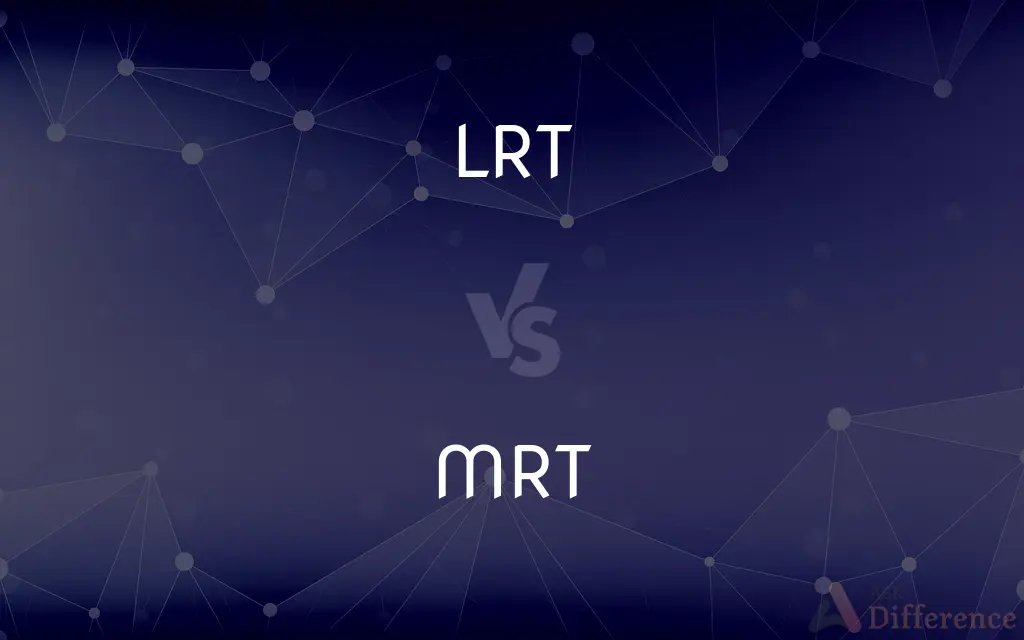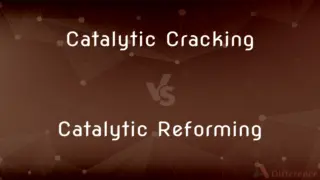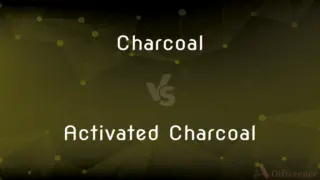LRT vs. MRT — What's the Difference?
Edited by Tayyaba Rehman — By Fiza Rafique — Published on December 29, 2023
LRT stands for Light Rail Transit, typically operating at street level with frequent stops. MRT stands for Mass Rapid Transit, often an underground or elevated system with faster speeds and fewer stops.

Difference Between LRT and MRT
Table of Contents
ADVERTISEMENT
Key Differences
LRT, or Light Rail Transit, is a form of urban rail transport that usually operates at the street level. MRT, on the other hand, stands for Mass Rapid Transit, a heavy rail subway or elevated system primarily used in urban areas. While LRT generally integrates with road traffic and may have crossings, MRT systems are typically segregated from other forms of traffic, ensuring smoother and faster rides.
LRT systems are often found in cities where the demand for transport is significant but not enough to justify the cost and infrastructure of a full MRT system. MRT, conversely, is built in densely populated urban regions, where high-speed, high-capacity transit is necessary to transport vast numbers of people efficiently.
Another distinction is the speed and frequency of stops. LRT usually stops more frequently, serving neighborhoods and facilitating short-distance travel. MRT systems, however, have fewer stops, placed at more strategic locations, allowing passengers to cover longer distances quickly.
The design and construction costs of LRT are generally lower than that of MRT. LRT systems are less intrusive, given their street-level nature, and may not always require dedicated tracks. MRT systems, being underground or elevated, demand extensive infrastructure, translating to higher expenses.
From a passenger experience perspective, LRT can feel more integrated into the city, offering scenic street views during the journey. MRT provides a rapid, efficient mode of transport, ideal for daily commuters looking to travel long distances in short periods.
ADVERTISEMENT
Comparison Chart
Infrastructure
Often at street level
Underground or elevated
Integration with Traffic
Mixed with road traffic, might have crossings
Segregated from other traffic
Speed & Frequency
Slower with frequent stops
Faster with fewer stops
Cost
Generally lower
Higher due to complex infrastructure
Typical Use Case
Short-distance travel in moderately populated areas
Long-distance in densely populated areas
Compare with Definitions
LRT
LRT often offers passengers scenic views of the city during transit.
Riding the LRT gives tourists a beautiful glimpse of the city's landmarks.
MRT
MRT stands for Mass Rapid Transit, indicating its capacity and speed.
The city's MRT can handle thousands of passengers during peak hours.
LRT
LRT is a type of public transport using rail, often at street level.
The city introduced a new LRT line to help decrease traffic congestion.
MRT
MRT systems are typically underground or elevated, segregated from other traffic.
With the MRT, you avoid the city's traffic jams since it runs on its own dedicated tracks.
LRT
LRT systems are more cost-effective but have a lower capacity compared to heavy rail.
The city chose LRT due to budget constraints and the lesser demand in the suburbs.
MRT
MRT caters to longer-distance travel with fewer but strategic stops.
I take the MRT daily to work because it skips the local stops and gets me there faster.
LRT
LRT stands for Light Rail Transit, often integrating with other traffic.
The LRT system in our town coexists seamlessly with regular road vehicles.
MRT
MRT is a rapid transit system used in urban areas.
The MRT line connects the north and south parts of the city efficiently.
LRT
LRT is a transit system with frequent stops, suitable for shorter distances.
The downtown area is easily accessible via LRT, thanks to its numerous stations.
MRT
MRT is a high-speed, high-capacity mode of public transport.
During the festival, the MRT was packed, but its efficiency ensured everyone reached their destinations on time.
Common Curiosities
Is MRT usually above ground or below?
MRT can be either underground or elevated, segregated from other traffic.
Which is faster, LRT or MRT?
MRT is generally faster due to fewer stops and dedicated tracks.
Where does LRT typically operate?
LRT typically operates at street level, often integrating with other road traffic.
What does LRT stand for?
LRT stands for Light Rail Transit.
And MRT?
MRT stands for Mass Rapid Transit.
Do LRT systems always operate at street level?
While many LRT systems operate at street level, some might have sections that are elevated or underground.
How are MRT systems different from regular trains?
MRT systems are designed for urban areas with frequent services, high capacity, and fewer stops compared to regular trains.
Is LRT more expensive to build than MRT?
LRT is generally less expensive to build compared to MRT.
Which offers a more scenic view, LRT or MRT?
LRT often offers more scenic views as it operates at street level, allowing passengers to see the city.
Which has a higher passenger capacity, LRT or MRT?
MRT typically has a higher passenger capacity than LRT.
Which system, LRT or MRT, is more suitable for densely populated cities?
MRT is more suitable for densely populated cities due to its high capacity and speed.
Are MRT systems always electric?
While most MRT systems are electric, the specific mode can vary depending on the city and its infrastructure.
Can LRT and MRT systems intersect or connect?
Yes, in many cities, LRT and MRT systems intersect or connect, allowing passengers to transfer between them.
How often does LRT typically stop?
LRT stops more frequently than MRT, catering to short-distance travel.
Share Your Discovery

Previous Comparison
Formal Research vs. Informal Research
Next Comparison
Catalytic Cracking vs. Catalytic ReformingAuthor Spotlight
Written by
Fiza RafiqueFiza Rafique is a skilled content writer at AskDifference.com, where she meticulously refines and enhances written pieces. Drawing from her vast editorial expertise, Fiza ensures clarity, accuracy, and precision in every article. Passionate about language, she continually seeks to elevate the quality of content for readers worldwide.
Edited by
Tayyaba RehmanTayyaba Rehman is a distinguished writer, currently serving as a primary contributor to askdifference.com. As a researcher in semantics and etymology, Tayyaba's passion for the complexity of languages and their distinctions has found a perfect home on the platform. Tayyaba delves into the intricacies of language, distinguishing between commonly confused words and phrases, thereby providing clarity for readers worldwide.











































